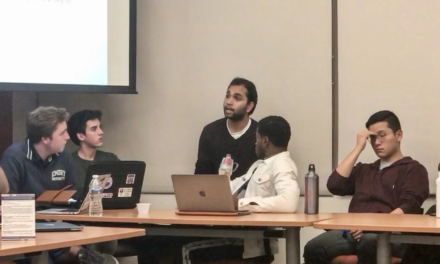
Two Goizueta Business School professors take their marketing and analytics expertise and apply it to the sports world though their blog, “Emory Sports Marketing Analytics.”
Assistant Professor of Marketing Manish Tripathi and Associate Professor of Marketing Michael Lewis together conduct research that explores the business behind sports, examining issues ranging from racially insensitive mascots and their effect on revenue and team branding to fan loyalty.
Since the blog’s inception in 2013, the blog has garnered more than a half million page views.
Their research has gained traction following coverage by various media outlets including The New York Times, The Wall Street Journal, ESPN and Deadspin sports blog.
Most recently, ESPN commentator Keith Olbermann spent his infamous closing monologue on his late night sports show “Olbermann” discussing the findings from a 2013 “Emory Sports Marketing Analytics” report.
The research he discussed was in reference to Tripathi’s and Lewis’ research that has shown that the Washington Redskins football team loses $1.6 million per year in part because many people perceive their Native American mascot to be racially insensitive.
This finding, coupled with national media attention, has once again furthered the debate on racially insensitive mascots. Tripathi and Lewis had to understand brand equity, the value of a name or brand, before concluding that racially insensitive mascots may hurt revenue.
“Every sports team is a brand, and people pay money to watch those teams,” Tripathi said. “We tried to quantify the brand equity for different teams, starting with college basketball.”
After Tripathi and Lewis were able to quantify brand equity, they were able to run statistical models to understand how the team mascot played into that.
“The Redskins have been losing brand equity over the past few years, and part of that could be attributed to the fact that they have a Native American mascot,” Tripathi said.
According to Tripathi, many sports teams have switched from Native American mascots. For example, Syracuse University changed their mascot from the Saltine Warrior to Otto the Orange to eliminate potentially offensive Native American themes.
Using this information, Tripathi and Lewis were able to understand the effect of switching to a mascot that does not portray Native Americans.
“We found that there was a small initial hit of revenue, but it was made up by an increase in revenue later on,” Tripathi said.
Following the completion of their research, these findings were published on their blog. According to Tripathi, the marketing techniques applied to business can also be applied to sports.
About a year ago, Tripathi and Lewis decided to apply their knowledge of marketing to sports.
Tripathi said there has been a big push in the last few years to improve on-field performance using statistics and analytics.
“We decided to look at the other side, which is: how do you apply data and analytics to understand the business of sports off the field?” Tripathi said.
Much of the work that Lewis and Tripathi have done has been emphasized in their class BUS447: Sports Marketing, in which students are exposed to speakers who talk about the business of sports.
“It’s a sports context, but really Sports Marketing is a marketing and analytics class.” Tripathi said.
A number of students have found that the class is not only enjoyable but also applicable in many business settings.
“I really liked that we got exposure to guest speakers who gave us perspectives from different careers in sports,” said Kevin Lujack, a Goizueta senior. “We got a lot of knowledge that you can’t get from a class that was lecture based.”
Tripathi, Lewis and Tom Smith, assistant professor in the Practice of Finance, will teach a new class called Predictive Sports Analytics next fall, which will focus on statistics and analytics within sports.
According to Tripathi, mascots are only a very small part of what the blog and the class encompass.
“We look at questions including, ‘should athletes be paid, and should Emory be moved to Division 1?'” he said.
Some of Tripathi’s students are currently working on a project aimed to understand fan loyalty and rank it quantitatively in the Indian Premiere League of cricket.
“There are so many questions out there that we can answer, and we are just starting to scratch the surface,” Tripathi said. “Through the blog and the class we are going to be able to continue this.”
The Emory Sports Marketing Analytics blog has had nearly 500,000 views since it started over a year ago. When Tripathi and Lewis released NFL brand equity rankings, the blog received nearly 47,000 visitors that day.
“The NFL is king,” Tripathi said.
According to Tripathi, they hope is to eventually feature student work on the Emory Sports Marketing Analytics blog.
–By Brandon Fuhr
The Emory Wheel was founded in 1919 and is currently the only independent, student-run newspaper of Emory University. The Wheel publishes weekly on Wednesdays during the academic year, except during University holidays and scheduled publication intermissions.
The Wheel is financially and editorially independent from the University. All of its content is generated by the Wheel’s more than 100 student staff members and contributing writers, and its printing costs are covered by profits from self-generated advertising sales.






